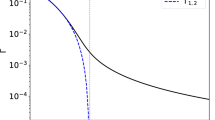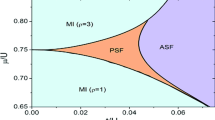Abstract.
This paper is the continuation of the analysis of bound quantum systems started in part I (A.L. Kholmetskii, T. Yarman and O.V. Missevitch, Going from classical to quantum description of bound charged particles. I: Basic concepts and assertions), which is based on a novel approach to the transition from classical to quantum description of electrically bound charges, involving the requirement of energy-momentum conservation for the bound electromagnetic (EM) field, when the EM radiation is forbidden. It has been shown that the modified expression for the energy levels of hydrogenic atoms within such a pure bound field theory (PBFT) provides the same gross and fine structure of energy levels, like in the standard theory. At the same time, at the scale of hyperfine interactions, our approach, in general, does evoke some important corrections to the energy levels. Part of such corrections, like the spin-spin splitting in the hydrogen atom, is less than the present theoretical/experimental uncertainties in the evaluation of hyperfine contributions into the atomic levels. But the most interesting result is the appearance of a number of significant corrections (the 1S -2S interval and 1S spin-spin interval in positronium, 1S and 2S -2P Lamb shift in light hydrogenic atoms), which improve considerably the convergence between theoretical predictions and experimental results. In particular, the corrected 1S -2S interval and 1S spin-spin splitting in positronium practically eliminate the existing up-to-date discrepancy between theoretical and experimental data. The re-estimated classic 2S -2P Lamb shift as well as ground-state Lamb shift in the hydrogen atom lead to the proton charge radius r p = 0.841(6) fm (from 2S -2P Lamb shift), and r p = 0.846(22) fm (from 1S Lamb shift), which perfectly agrees with the latest estimation of proton size via the measurement of 2S -2P Lamb shift in muonic hydrogen, i.e. r p = 0.84184(67) fm. Finally, we consider the decay of bound muons in meso-atoms and achieve a quantitative agreement between experimental data and the results obtained through our approach.
Similar content being viewed by others
References
A.L. Kholmetskii, T. Yarman, O.V. Missevitch, Eur. Phys. J. Plus 126, 33 (2011)
R. Pohl, A. Antognini, F Nez et al., Nature 466, 213 (2010)
M.I. Eides, H. Grotch, V.A. Shelyuto, Theory of Light Hydrogenic Bound States (Springer-Verlag, Berlin, Heidelberg) 2007
K. Pachuski, D. Leibfried, M. Weitz et al., J. Phys. B 29, 177 (1996)
S.G. Karshenboim, Phys. Rep. 422, 1 (2005)
V.B. Berestetskii, E.M. Lifshits, L.P. Pitaevskii, Quantum Electrodynamics, 2nd edition (Pergamon Press, Oxford, 1982)
A.L. Kholmetskii, O.V. Missevitch, T. Yarman, Am. J. Phys. 78, 428 (2010)
V. Meyer, S.N. Bagaev, P.E.G. Baird et al., Phys. Rev. Lett. 84, 1136 (2000)
H.A. Bethe, E. Salpeter, Quantum Mechanics of One- and Two-Electron Atoms (Plenum, New York, 1977)
S. Klarsfeld et al., Nucl. Phys. A 456, 373 (1986)
M.S. Fee, A.P. Mills jr., S. Chu et al., Phys. Rev. Lett. 70, 1397 (1993)
M.W. Ritter, P.O. Egan, V.W. Hughes, K.A. Woodle, Phys. Rev. A 30, 1331 (1984)
A.P. Mills Jr., G.H. Bearman, Phys. Rev. Lett. 34, 246 (1975)
Particle Data Group (C. Amsler et al.), Phys. Lett. B 667, 1 (2008)
S.G. Karshenboim, ArXiv: hep-ph/8137v1
P.I. Mohr, B.N. Taylor, D.B. Newell, Rev. Mod. Phys. 80, 633 (2008)
D.J. Drickey, L.N. Hand, Phys. Rev. Lett. 9, 521 (1962)
G.G. Simon, Ch. Schmidt, F. Borkowski, V.H. Walther, Nucl. Phys. A 333, 381 (1980)
A. van Wijngaarden, J. Kwela, G.W.F. Drake, Phys. Rev. A 43, 3325 (1991)
A. van Wijngaarden, F. Holuj, G.W.F. Drake, Phys. Rev. A 63, 012505 (2000)
R.W. Huff, Ann. Phys. (N.Y.) 16, 288 (1961)
D.D. Yovanovitch, Phys. Rev. 117, 1580 (1960)
T. Yarman, Found. Phys. Lett. 19, 675 (2006)
T. Yarman, Ann. Fond. Louis de Broglie 29, 459 (2004)
T. Yarman, A Novel Approach to The End Results of the General Theory of Relativity and to Bound Muon Decay Rate Retardation, in DAMOP 2001 Meeting, APS, May 16 -19, 2001, London, Ontario, Canada (APS, New York, 2002)
T. Yarman, The Quantum Mechanical Framework Behind the End Results of the General Theory of Relativity: Matter is Built on a Universal Matter Architecture (Nova Publisher, in press)
A.L. Kholmetskii, T. Yarman, O.V. Missevitch, B.I. Rogozev, Phys. Scr. 79, 065007 (2009)
I.M. Blair, H. Muirhead, T. Woodhead, J.N. Woulds, Proc. Phys. Soc. (London) 80, 938 (1962)
Author information
Authors and Affiliations
Rights and permissions
About this article
Cite this article
Kholmetskii, A.L., Yarman, T. & Missevitch, O.V. Going from classical to quantum description of bound charged particles II: Implications for the atomic physics. Eur. Phys. J. Plus 126, 35 (2011). https://doi.org/10.1140/epjp/i2011-11035-7
Received:
Accepted:
Published:
DOI: https://doi.org/10.1140/epjp/i2011-11035-7




